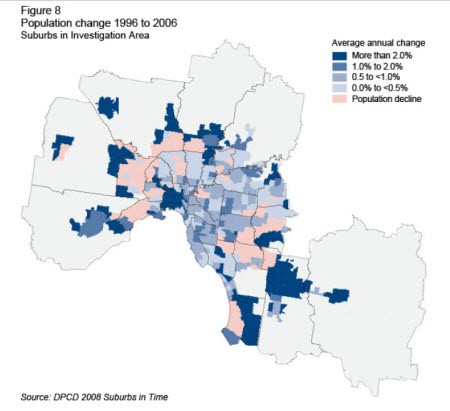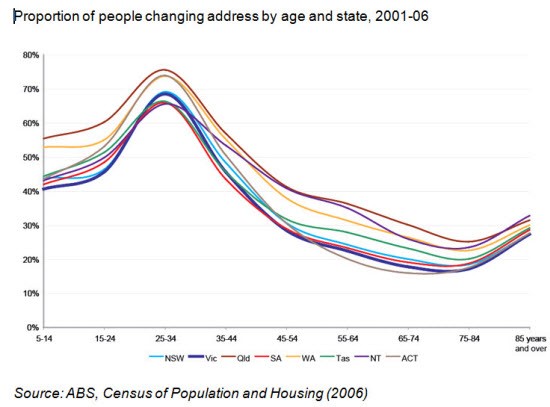This article at Club Troppo, We’re not full, has generated lots of interest on the net (e.g. here) because the writer argues that, contrary to what population growth opponents contend, Sydney is far from “bursting at the seams”.
The key evidence he offers is that many older suburbs that were settled in the 1960s and ’70s, like Campbelltown, are losing population. This is largely because the children of those early settlers have grown up and left home, leaving mum and dad getting older and rattling around in a home with three or more bedrooms.
I completely agree that Sydney is not bursting at the seams, but regular readers of The Melbourne Urbanist will know instinctively that there’s more to this issue than meets the eye. These suburbs are not really “emptying out”.
The “empty nester” and “ageing in place” phenomena are evident in other Australian cities too. In Melbourne, for example, this report shows there’s an “ageing donut” of middle ring suburbs about 10-15 kilometres from the CBD where persons aged 65 years or older are significantly over-represented.
Older households in Australia are, on average, spoilt for space. This research shows more than 84% of them live in homes that are under-occupied (one or more spare bedrooms) when measured against the Canadian National Occupancy Standard. Almost half have two or more spare bedrooms.
It’s these sorts of numbers that have driven policy-makers to try and find ways to discourage ageing in place. It seems an awfully inefficient use of space when there’s an acknowledged shortage of housing in accessible locations.
Older households would be better off, the argument goes, if they were to move to locations with better access to public transport and shops. They’d also have lower maintenance costs. The community would be better off too because the vacated houses could be occupied by larger households or, even better, redeveloped for multi-unit housing.
But contrary to much misinformed opinion, older households don’t want to move. One study found more than 90% of them want to stay put. They value their proximity to friends and family and they value familiarity with their home and neighbourhood.
Census data bears this out. For example, while more than 70% of Victorians aged 25-29 changed address between the 2001 and 2006 censuses, less than 20% of those aged 65-74 moved house over the same period. And moves of older persons are in any event more likely to be related to health issues or the death of a partner than to any desire to move to a smaller house or better location.
Empty nesters also utilise space more fully than is often appreciated. More than 90% regard the size of their home as efficient and suitable to their needs. One study reported that:
“People comment that following retirement they spend most of their time at home and they need space ‘to get away from each other and not to always be underfoot’, to follow hobbies and sometimes part-time paid work … People state they need room for temporary residents — for frequent visits from children and grandchildren, other relatives and friends.”
A related study of older home owners found that 23% had one or more temporary residents at the time of the survey. While almost a fifth of these were grandchildren, more than half were adult children and visitors.
No, Sydney and our other cities are not “bursting at the seams”, as I’ve argued before (here, here and here). But, nor is it accurate to characterise the ageing donut suburbs as “emptying”. The vast bulk of older residents don’t plan on going anywhere soon voluntarily.
Still, there will be some households at the margin who would downsize if given the right incentives. As the great majority of older households own their homes outright, stamp duty is likely to be a major obstacle, especially in Victoria. A tax related to the development potential of properties would provide a significant incentive to down-size, although that’s not very likely.
But I suspect the biggest barrier is the price of alternative housing — as one participant at this conference remarked, “a unit in Box Hill costs as much as a house”. As I’ve discussed previously, constraints on the supply of multi-unit housing in established suburbs is a very serious, albeit difficult, issue that governments have to get serious about.
Although she was dismissed by Club Troppo’s writer, the author of this government research report has the most realistic take on this issue. Talking about the ageing donut ring, she says: “over time such suburbs will see an ageing and dying off of older populations and a renewal as new households move into the area”.
The article first appeared on The Melbourne Urbanist.











As a retiree I would love to downsize if I could stay in my neighbourhood.My house is in need of maintenance I can’t afford and I would like to have access to money from it, my only asset. But if I sell my home I cannot afford to buy anything else anywhere near the place I have lived for 20 years. If anyone has an answer I’d love to hear it.
“But, nor is it accurate to characterise the ageing donut suburbs as “emptying”. The vast bulk of older residents don’t plan on going anywhere soon voluntarily.”
But aren’t these suburbs actually emptying in terms of the number of people living there, compared to the number who previously did? Just because the parents/retirees aren’t thinking of moving away like their children doesn’t mean that the suburb in question is not emptying.
But I guess your point is more about how while the suburb’s population might be reducing, the number of available houses is not increasing because the density is lowering…
Liz, we found an interesting solution while living in Athens, Greece. Older families were “selling” their older houses to a developer and then “buying” their pick of the apartments that were built on the, now vacant, block. Not sure where they lived while building took place, but it seemed to work.
Why talk at all about ‘suburbs … where persons aged 65 years or older are significantly over-represented’? What’s wrong with that? Do all areas have to have a ‘representative’ mix of ages? What’s wrong with the over 65s? Or the 55s and over for that matter (since I’m one of them and feel fairly normal to myself)?